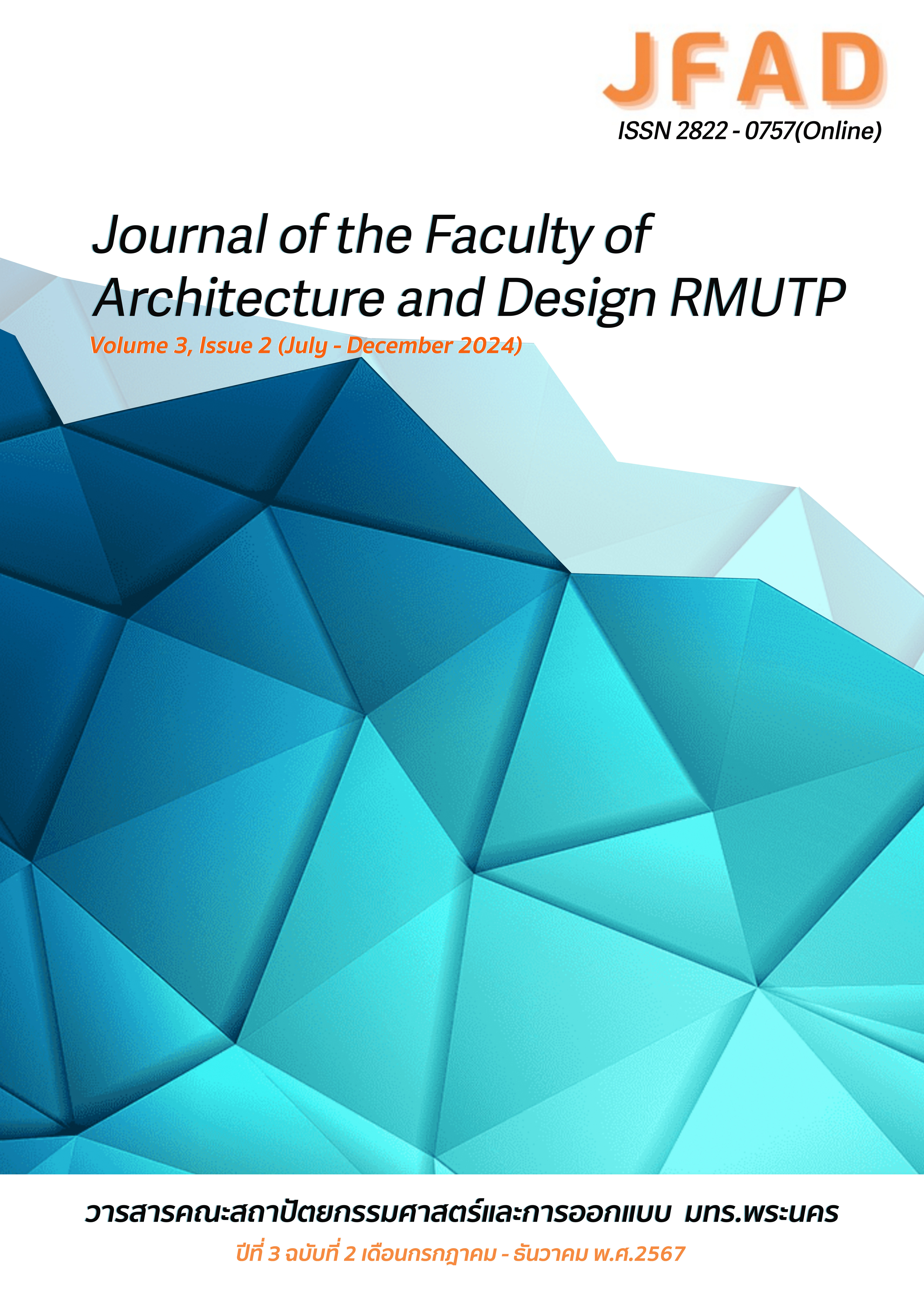Design Guidelines for the Bangkok NCDs Health Promotion and Disease Prevention Center
Main Article Content
Abstract
The Bangkok NCD Health Promotion and Disease Prevention Center project is designed as a space to promote the well-being of people across all age groups, inspiring a healthy lifestyle physically, mentally, and socially. The objective is to help address health issues stemming from daily lifestyle behaviors that increase the risk of NCDs (Non-Communicable Diseases). Environmental factors also contribute to NCD risks, including PM2.5 dust, noise levels over 50 decibels that lead to high blood pressure, and nighttime lighting linked to an increased risk of diabetes (Source: RISC Well-being, 2023).
The conceptual framework involves studying NCDs, which include diabetes, cardiovascular diseases, emphysema, cancer, hypertension, and metabolic syndrome. The project’s design and space usage will be tailored to promote health and learning. The project site, located on Srinagarindra Road, Suan Luang District, Bangkok, area 10,167 sq.m. It is easily accessible and close to the community. Environmental issues can be addressed through architectural design based on WELL standards, which focus on enhancing the well-being of building users. This sets the design of the Bangkok NCDs Health Promotion and Disease Prevention Center apart from conventional health centers.
The building consists of five floors, housing areas for health promotion, learning, shops, restaurants, offices, and other. The design primarily uses passive design principles, featuring an open central space for ventilation. Natural light is utilized in accordance with WELL standards for lighting, ensuring good light penetration to the lower floors. Green spaces and vertical gardens are incorporated to create relaxing areas on every floor. Additionally, there are activity spaces and ramps, which align with WELL standards for movement, providing areas that promote regular physical activity for better well-being.
Article Details

This work is licensed under a Creative Commons Attribution-NonCommercial-NoDerivatives 4.0 International License.
Copyright (c) 2023 : Faculty of Architecture and Design, Rajamangala University of Technology Phra Nakhon
References
กรมควบคุมโรค (2567). จำนวนและอัตราตายด้วย 5 โรคไม่ติดต่อ ปี 2561 - 2565 "New อัพเดทข้อมูล 1/11/67 [ออนไลน์]. ค้นเมื่อ 6 กันยายน 2567, จาก https://www.ddc.moph.go.th/ dncd/news.php?news=39911
กรมโยธาธิการและผังเมือง. (2565). กฎหมายที่เกี่ยวข้องกับการออกแบบ [ออนไลน์]. ค้นเมื่อ 7 ตุลาคม 2565, จาก: https://www.bsa.or.th.
กองโรคไม่ติดต่อ กรมควบคุมโรค กระทรวงสาธารณสุข. (2565). โรคไม่ติดต่อและหลักการควบคุมโรคไม่ติดต่อ. หลักสูตรการป้องกันควบคุมโรคไม่ติดต่อ สำหรับผู้นำท้องถิ่น [ออนไลน์]. 2565(1), ค้นเมื่อ 6 กันยายน 2567, จาก: https://fliphtml5.com/hvpvl/mfwm/หลักสูตรการป้องกันควบคุมโรคไม่ติดต่อ สำหรับ ผู้นำท้องถิ่น.
คเณศ นิพัทธ์ธีรนันท์. (2562). มาตรฐาน WELL Building Standard [ออนไลน์]. ค้นเมื่อ 15 กุมภาพันธ์ 2567, จาก: https://thestandard.co/anil-sathorn-12.
โรงพยาบาลบำรุงราษฎร์. (2564). ความหมายนิยามของคำว่า โรค NCDs [ออนไลน์]. ค้นเมื่อ 5 ตุลาคม 2565, จาก: https://www.bumrungrad.com/th.
ศูนย์สารสนเทศกรุงเทพมหานคร. (2565). ข้อมูลกรุงเทพมหานคร [ออนไลน์]. ค้นเมื่อ 23 ตุลาคม 2566, จาก: https://apps.bangkok.go.th, 23 ตุลาคม 2566.
สำนักผังเมือง. (2556). แผนผังกำหนดการใช้ประโยชน์ที่ดินตามที่ได้จำแนกประเภทท้ายกระทรวงให้ใช้บังคับผังเมืองรวมกรุงเทพมหานคร พ.ศ.2556 [ออนไลน์]. ค้นเมื่อ 28 พฤศจิกายน 2564, จาก: https://download.asa.or.th/03media/04law/cpa/mr56-bma-landuse.pdf.
สิงห์ อินทรชูโต (2567). NCD-less Architectural Framework. งานประชุมวิชาการด้าน NCD การออกแบบ ชุมชนเมืองน่าอยู่และยั่งยืน, 23 กุมภาพันธ์ 2567. ไอคอนสยาม.
Google Map. (2566). ค้นที่ตั้งโครงการ [ออนไลน์]. ค้นเมื่อ 5 ตุลาคม 2565, จาก: https://www.google.co.th/maps/place/Linnas+Thailand/@13.7378275,100.6394319,225m/
RISC. (2566). สภาพแวดล้อมรอบตัว อีกตัวแปรที่เพิ่มแนวโน้มการเกิดโรค NCDs [ออนไลน์]. ค้นเมื่อ 6 กันยายน 2567, จาก: https://risc.in.th/th/knowledge.
World Health Organization. (2019). Noncommunicable diseases [ออนไลน์]. นเมื่อ 24 กันยายน 2564, จาก: https://www.who.int/publications/i/item.


